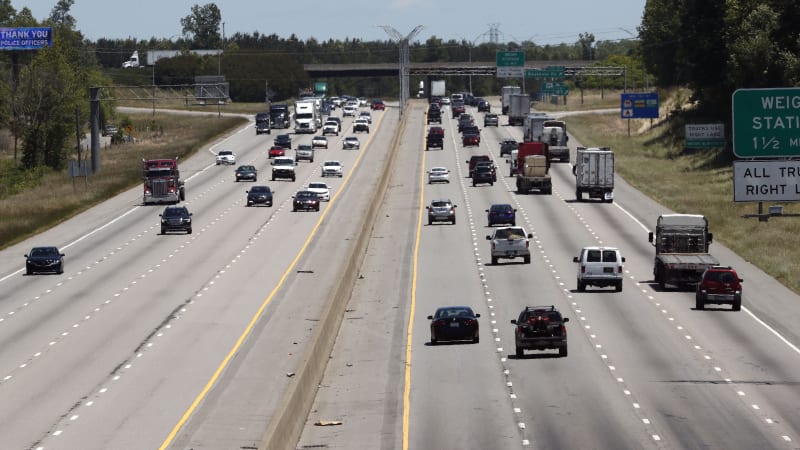Americans weary of coronavirus lockdown getting back on the road
https://ift.tt/2SZpRKH

Cars on Interstate 40/85 in Mebane, N.C., Monday, May 11. Americans are slowly getting back on the road after hunkering down amid the cornonavirus pandemic, though driving still is well below normal. / AP
OAK PARK, Illinois — Americans are slowly getting back on the road after hunkering down due to the coronavirus, though the volume of traffic is still well below what it was before many states issued stay-at-home orders.
Drivers in the U.S. have been more active in the past week than at any time since mid-March, according to an AP analysis of StreetLight Data Inc., an analytics software company that aggregates data from smartphones and other GPS-enabled devices and combines it with information from maps and other sources to provide county-level data on vehicle miles traveled.
The most recent data show that activity during the seven-day period ending May 8 was 60% higher than the lowest point since the COVID-19 crisis began. However, activity still was down 49% compared to January 2020 and well below what would be expected in the spring under normal circumstances.
In Minnesota, typical freeway traffic dropped off sharply after the governor issued a stay-at-home order in March. On April 12, Minnesota Department of Transportation data shows traffic in the Twin Cities metro area was 71% lower than it was on the same day a year ago, while statewide traffic was down 66% from a year earlier.
Since then, traffic has been inching up.
Tim Harlow, who covers traffic for the Minneapolis Star Tribune, said he’s been going out a couple of times a week to check on his mother, and last week he noticed more traffic during what would typically be rush hour. Department of Transportation data shows May 9 traffic was down 45% in the metro area from a year ago, and down 30% statewide, capping off a week of relaxed restrictions as about 20,000 businesses were allowed to reopen for curbside commerce.
“The data is showing that we are starting to move around a little bit more,” Harlow said. “I think some people are going back to work. I think other people are just kind of getting stir crazy. … We’re Americans — we don’t like to stay home.”
Although some states are easing restrictions, it’s not clear exactly why road traffic is on the rise, said Streetlight Data CEO Laura Schewel.
Some people may be lured into their vehicles by nice weather, because there has been a surge in some states that have not officially reopened yet, said Schewel. Farming and other activities that usually pick up in the spring could also be factors.
Schewel said there’s a bigger driving uptick in rural counties compared to urban and wealthier areas, where people were more likely to stop driving in the first place. People are leaving home more in areas where food delivery service is unavailable “and the grocery store might be 30 miles away,” she said.
People are driving less in states that clamped down and are not close to reopening soon. But there aren’t large differences in vehicle miles traveled in states without stay-at-home orders or where reopening is happening gradually.
Schewel said the return to driving won’t be as swift as the falloff was in March.
Michigan, Minnesota and Montana are among the states with the largest relative uptick in travel. Other states such as Virginia, New Mexico, Arizona, and Maryland have rebounded the least. But even in states with an increase in movement, the rebound is gradual and differs by county.
In southeast Michigan’s Wayne County, a national hot spot for COVID-19, the number of vehicle miles traveled on May 8 was 22.2 million, almost double what it was three weeks before but still a fraction of travel in early March before factories closed and Gov. Gretchen Whitmer ordered nonessential employees to stay home. Vehicle miles traveled were 76.3 million on March 6 and 56.8 million on March 13.
Michigan State Police Lt. Mike Shaw, whose district includes hard-hit Wayne, Oakland and Macomb counties, said traffic picked up after landscapers, construction workers and others were allowed to return to work, but it’s still unusually light. Crashes also are down, he said although more people are driving too fast and “not paying attention.”
AAA spokeswoman Jeanette Casselano said increases in gas prices in recent weeks signal rising demand as states reopen or make plans to do so. The greatest volatility has been in the Midwest and South.
“People in smaller metros may have more of a comfort level with venturing out,” Casselano said. But when they drive, she said, they don’t go far.
Wynne Anderson, part-owner and service manager of World Auto Repair in Eden Prairie, Minnesota, said his business dropped off 40% to 50% when the virus first hit. Anderson said people didn’t know if they were allowed to leave home to take their cars in for repair, or whether those shops were even open.
That’s all changed in recent weeks.
“They’re sitting at home with three cars in the driveway. College has been canceled for their kids, their jobs are working from home. Now they have three cars that need work they could never get to,” he said. “Guess what, perfect timing.”
Auto Blog
via Autoblog https://ift.tt/1afPJWx
May 12, 2020 at 10:17AM
